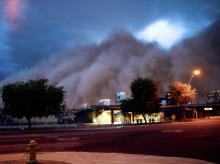Last week a dust storm a 100 miles wide and nearly a mile high hit Phoenix, Arizona; the result of thunderstorm cooled air plummeting into the ground. Wired Science explained it like mist pouring out of an open freezer, "only exponentially more powerful." The extreme drought in the area allowed these powerful winds to kick up cubic tons of dust that rolled over the Phoenix area; the biggest, meteorologists say, in at least 30 years. Many have compared it to the bizarre dust storms in Sydney, Australia and China's Gobi Desert. Others call it a return to the devastating Dust Bowl storms that decimated agriculture land and livelihoods.
The Phoenix dust storm is an example of a 'perfect storm' (no pun intended) of circumstances that seem increasing in latter years as climate change takes a greater hold on weather manifestations. Much of the southwest has been experiencing widespread drought, some areas since the 1990's. In fact, according to climatologists, precipitation in the southwest on average is 50% of what it was 75 years ago in the same region. Additionally, the average temperature of this area of the country has risen 1.5 degrees, and will rise more steeply, between 4 and 10 degrees Fahrenheit by the end of this century, according to the USGCRP. Whenever there is less precipitation and more heat the factors create ideal conditions for wild fires and dust storms. These factors also, according to the U.S. Geological Survey, decrease plant density. Understandably, fewer plants are able to grow in a region scorched by heat and lacking in precipitation. As plants die off there are less roots to provide topsoil stability, and to anchor that topsoil in place. Less moisture makes the soil more susceptible to wind erosion, and the result is more dust in the air. Combine these conditions with a weather event like a thunderstorm, or even more likely, shifting pressure cells, and the result is an enormous dust storm that removes precious topsoil, chokes plants, animals, and people, causes infrastructure damage, and over time can even lead to greater desertification and shrinking arable farmland, as happened in the 1930's.
In the early 20th century, decades of unsustainable farming practices lead to a decrease in the arability of the topsoil, lacking nutrients it was dry, cracked, and dusty. Add to that a drought that hit in the early 30's, and a series of powerful weather events created state-wide dust storms that literally removed millions of tons of topsoil from the farms and ranches of the Midwest and American Southwest and blew it as far as Washington D.C. and the Atlantic Ocean. One particularly bad dust storm stretched from Kansas City, Kansas to Chicago, Illinois in the same day. It was human activity that created these monsters, without question. However, others question whether these modern-day dust storms are.
It's difficult to definitively say that these conditions are the result of climate change since decades, even century-long drought and heat waves are not uncommon in arid regions. However, As these dust storms become more common in other areas of the globe as well, virtually simultaneously, there's strong correlation to global warming, rather than just regional warming.
Despite that, it is another chapter in a volume of evidence that is depicting climate change happening now, and manifesting in myriad ways in our nation alone; from gigantic dust storms in the American southwest, to thousand-year floods through the Midwest, tornadoes in New England, to measurable sea-rise in Florida. It astounds me that individuals in our own government can waves a dismissive hand at climate change, calling it a 'liberal lie', or 'sensationalism'. What happens to those individuals that were too cowardly, ignorant, or foolish to act when the global impacts of climate change become too devastating to ignore? By then, it probably won't matter.

